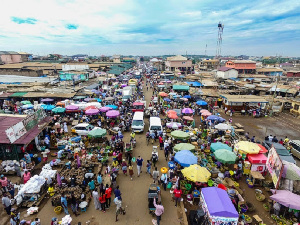Ashaiman is known to be a town in the Greater Accra Region, it is also the name of a municipality and yet still name of one of the largest constituencies in the capital region.
The town, municipality or constituency, if you like, has hogged news headlines since last week for all the bad reasons.
First, was the March 4, 2023 killing of a young soldier (Trooper Sherrif Imoro) and then came resultant swoop (March 7) by the military ostensibly to find the killers.
The sitting and former Members of Parliament have been busy defending innocent residents who may have been caught in the military swoop whiles condemning the violence that claimed the life of the soldier.
Parliament’s Defence and Interior Committee is due to visit the town and access the situation on the ground following the swoop that led to the arrest of 184 persons amid brutal teratment by the military.
All 184 persons have since been freed according to the MP for the area Ernest Henry Norgbey and the military despite affirming that the swoop was sanctioned by the Military High Command failed to state sanctions for its officers who overreacted during the swoop.
But what is behind the name Ashaiman?
A social media user, Evans Ago Tetteh, an adjunct lecturer and transport logistocs expert, who goes by the Twitter handle @MantseBiAgo, tweeted a version of the history behind the name, Ashaiman.
The tweet of March 10, 2023 read: “‘Ashaiman’ is a Ga word which means Ashai’s town. Ashai is the name given to a third male child of the Tema people. Ashaiman was founded in the early 17th century by some farmers from the Amorkortse We and Amuitse We of the Awudu division of Tema.
“This event took place at the time the Tema people lived in their ancestral home (the current location of the Meridian hotel in Tema). They were led by one Nii Ashai (hence the name Ashaiman) and his two brothers, Nii Amu and Nii Oko who settled in adjoining towns like Mantseman,” his tweet concluded.
GhanaWeb’s checks in official government reports also found another variant as contained in the 2010 Population and Housing Census (PHC) District Analytical Report on the Ashaiman Municipality:
It read under the heading: ‘Social and Cultural Structure’
Ashaiman was founded by one Nii Amui who migrated to the area from Tema in the 17th Century. Later, other migrants from the Accra Metropolitan Assembly area to the east of Tema came to settle in Ashaiman.
The area where they settled is present day Lebanon (a suburb of Ashaiman). Ewes from the Volta Region were among the earliest migrants who settled in the area.
Ashaiman’s current ethnic make-up
Currently, Ashaiman is home to people from many ethnic groups. The construction of Tema harbour and the railway line in the 1950s, contributed to the migration of people to the area in search of jobs and for relatively less expensive accommodation as compared to Accra and Tema.
The area is known for multi-traditional dances that are often performed during
festivals and other ceremonial occasions. Ashaiman is a cosmopolitan area which comprises large numbers of ethnic groups but no specific cultural festival is observed.
The major ethnic groups include Ga-Damgbe, Ewe, Guans, Hausa, Dagomba, Asante, Fante, among others.
The Municipality is dominated by Christians followed by the Moslems and the traditionalist constituting the smallest proportion. Ashaiman is a sprawling “urban settlement”, parts of which exhibit characteristics of a slum.
 Home Of Ghana News Ghana News, Entertainment And More
Home Of Ghana News Ghana News, Entertainment And More





